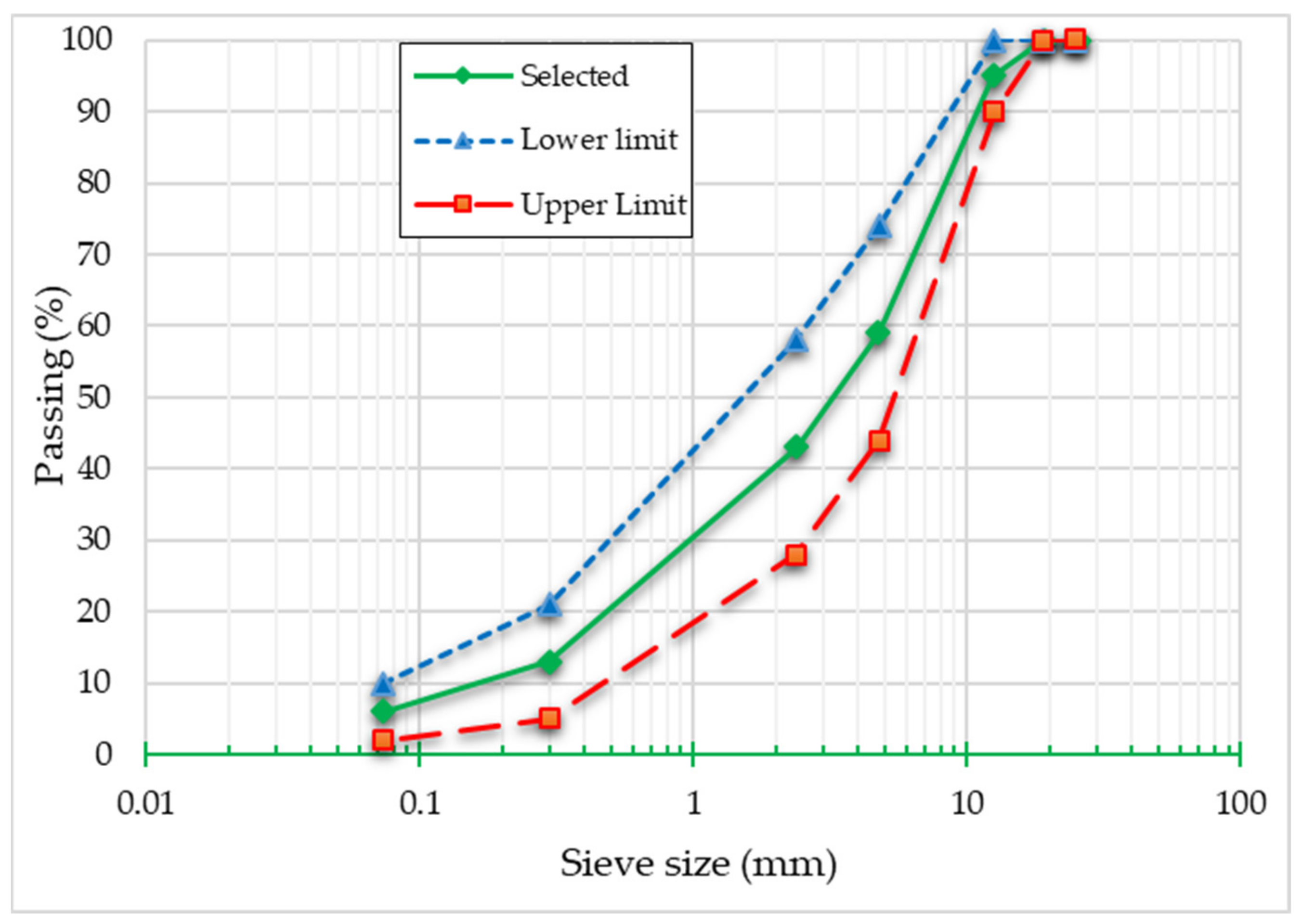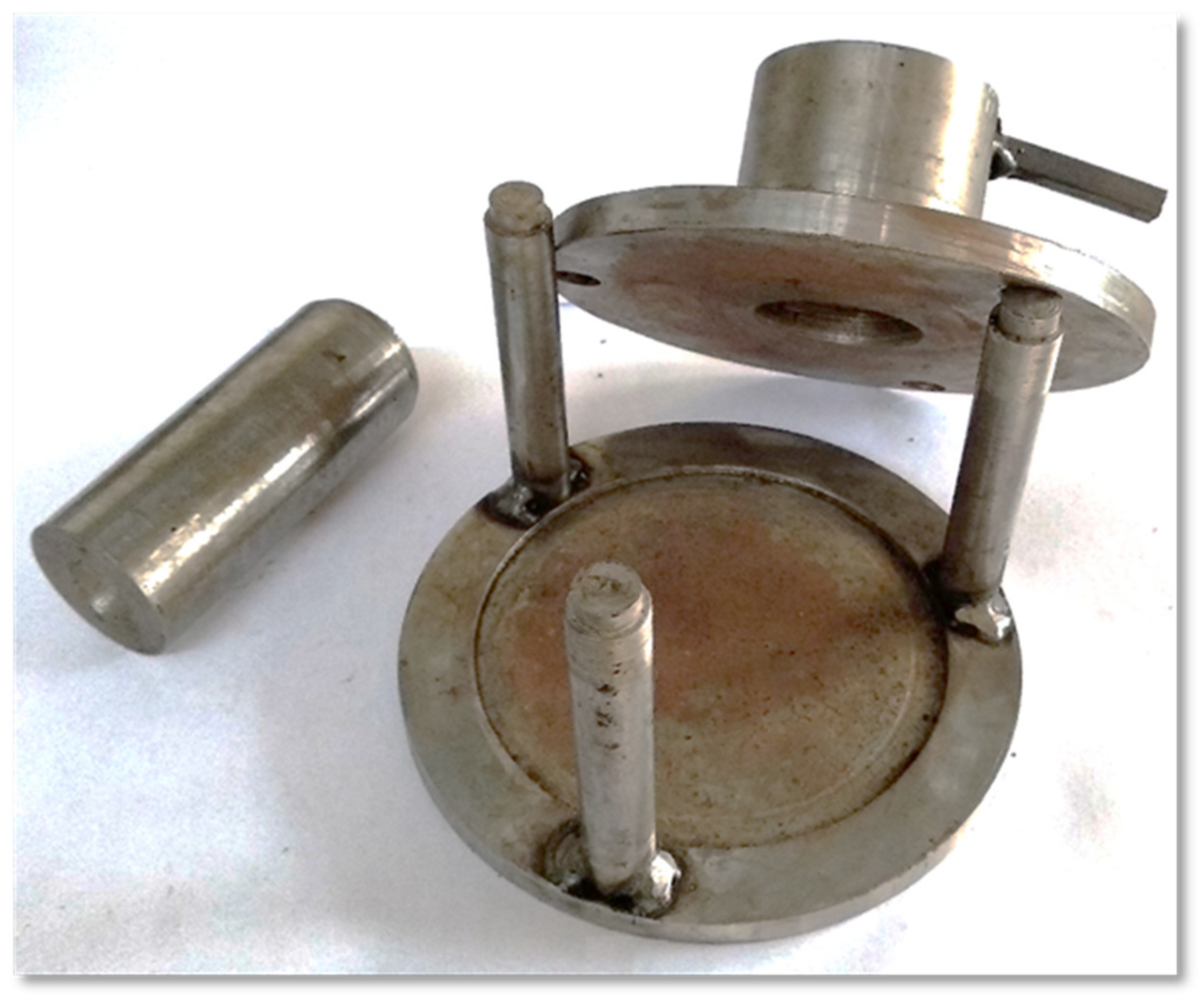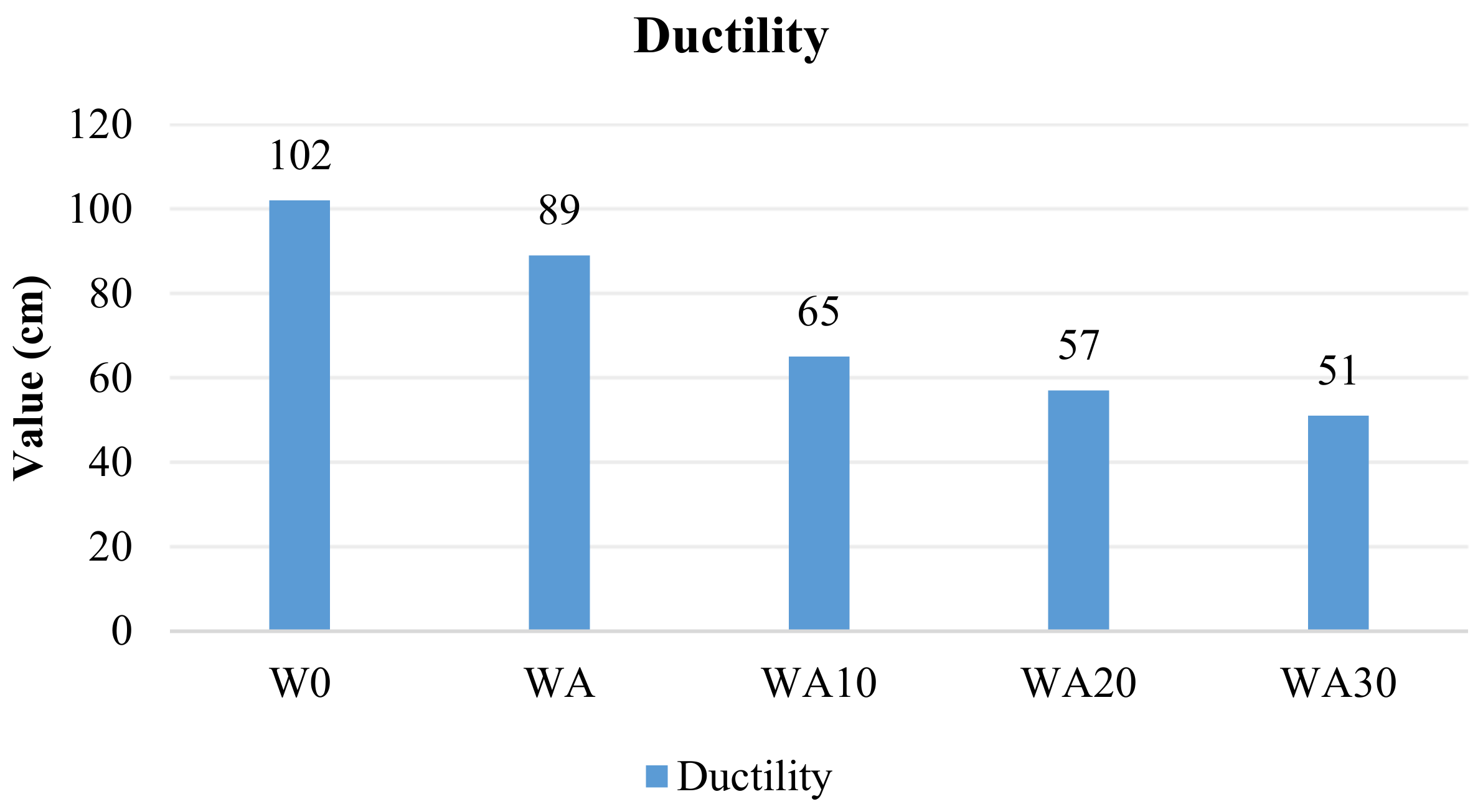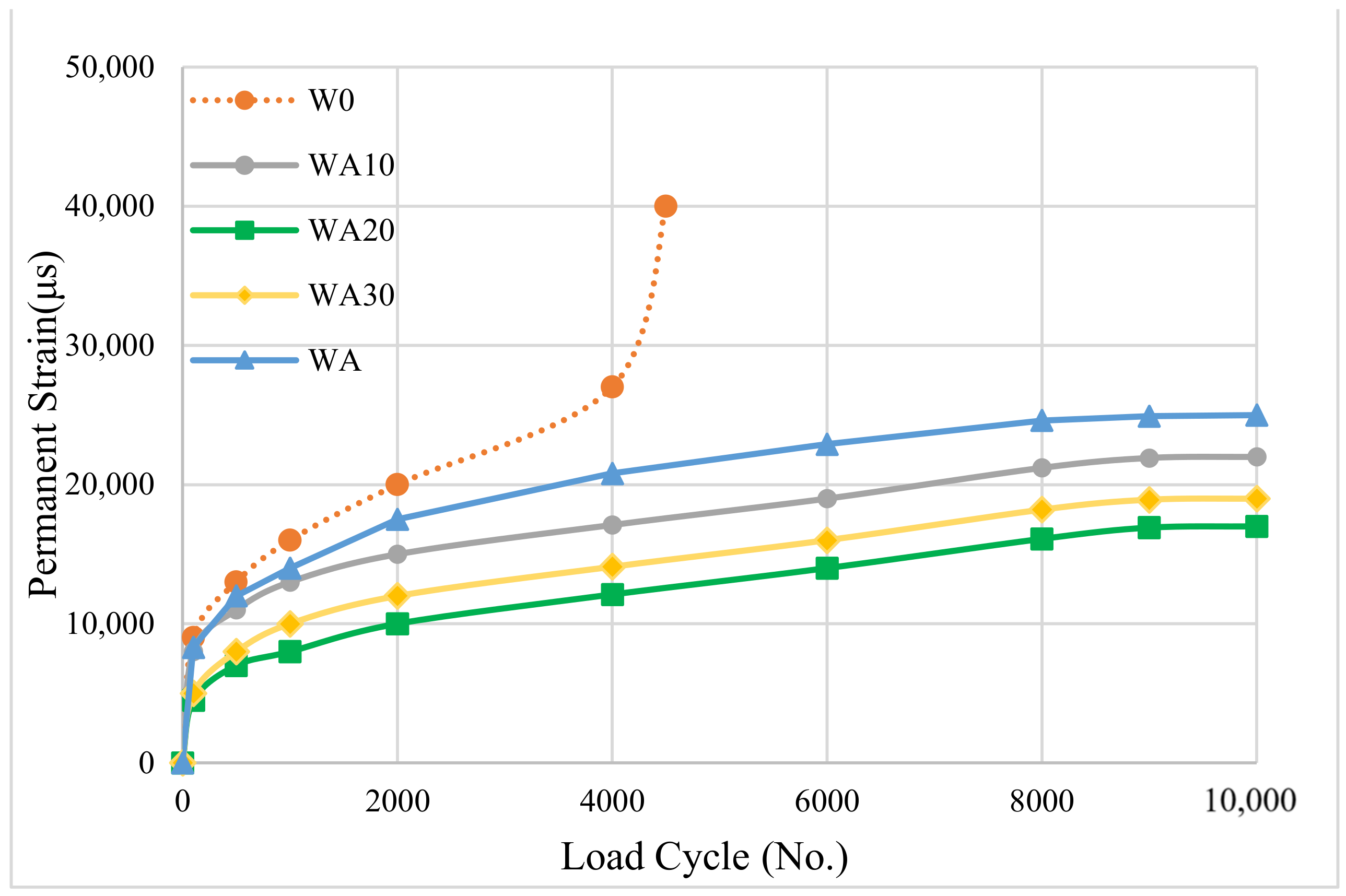Performance Evaluation of WMA Containing Re-Refined Acidic Sludge and Amorphous Poly Alpha Olefin (APAO)
Abstract
:1. Introduction
2. Materials and Methods
2.1. Experimental Plan
2.2. Materials
2.2.1. Virgin Bitumen
2.2.2. Re-Refined Acidic Sludge (RAS)
2.2.3. Aggregates
2.2.4. Amorphous Poly Alpha Olefin (APAO)
2.3. Sample Preparation
2.4. Tests
2.4.1. Conventional Bitumen Tests
2.4.2. Marshall Test
2.4.3. Moisture Sensitivity
Texas Boiling Water Test
Tensile Strength Ratio (TSR)
Retained Marshall Stability (RMS) Ratio
2.4.4. Permanent Deformation
Dynamic Creep Test
Kim Test
Marshall Quotient
2.4.5. Resilient Modulus (MR)
3. Results and Discussion
3.1. Conventional Bitumen Tests
3.2. Marshall Test
3.3. Moisture Susceptibility Test
3.3.1. TSR Ratio
3.3.2. Texas Boiling Water Test
3.3.3. Retained Marshall Stability (RMS) Ratio
3.4. Permanent Deformation
3.4.1. Kim Test
3.4.2. Dynamic Creep Test
3.4.3. Marshall Quotient
3.5. Resilient Modulus (MR)
4. Conclusions
- The addition of RAS and APAO to bitumen reduced the degree of penetration, and the lowest penetration value is related to bitumen contained 30% of RAS and polymer. Moreover, samples containing RAS additive had a higher softening point than the control sample, with the highest amount at 30% of RAS, indicating a more rigid bitumen that results in this compound’s lower potential for resistance to cracking in cold regions. Based on PI calculation, increasing the percentage of RAS has a more favorable effect on bitumen’s thermal sensitivity.
- RAS and polymer modified bitumen have increased the asphalt mixture’s Marshall stability compared to the control sample, with the highest increase (about 50%) in stability is related to the mixture containing 20% RAS and APAO.
- The addition of RAS and APAO to the asphalt mixture has increased the resistance of asphalt mixture against moisture damage, supported by results from the conducted tests in which 20% RAS had the superior durability. Morphology and chemical analysis also show more details about the RAS. It could increase the moisture resistance in asphalt mixtures but for proving that, it needs more investigations.
- Samples with RAS have a higher MR due to their higher stiffness than the control sample, which indicates that the modified asphalt mixture had appropriate resistance to permanent deformation, which can be a suitable mixture for paving with less thickness.
- The tests related to permanent deformation showed that the addition of 20% RAS and APAO had an excellent effect on the asphalt mixture resistance against permanent deformation. Moreover, the Kim test results were compatible with the dynamic creep test as an important test for determining the rutting potential of asphalt mixtures.
- Based on the laboratory test results, the APAO in combination with RAS modified asphalt mixture had better permanent deformation resistance at high temperatures and moisture stability than that of the control mixture. However, this is a laboratory-based study, and the environmental effects of these additives should be carefully considered in the future.
Author Contributions
Funding
Institutional Review Board Statement
Informed Consent Statement
Data Availability Statement
Conflicts of Interest
References
- Poulikakos, L.; Papadaskalopoulou, C.; Hofko, B.; Gschösser, F.; Falchetto, A.C.; Bueno, M.; Arraigada, M.; Sousa, J.; Ruiz, R.; Petit, C. Harvesting the unexplored potential of European waste materials for road construction. Resour. Conserv. Recycl. 2017, 116, 32–44. [Google Scholar] [CrossRef]
- Fakhri, M.; Javadi, S.; Sedghi, R.; Arzjani, D.; Zarrinpour, Y. Effects of deicing agents on moisture susceptibility of the WMA containing recycled crumb rubber. Constr. Build. Mater. 2019, 227, 116581. [Google Scholar] [CrossRef]
- Rubio, M.C.; Martínez, G.; Baena, L.; Moreno, F. Warm mix asphalt: An overview. J. Clean. Prod. 2012, 24, 76–84. [Google Scholar] [CrossRef]
- Shu, X.; Huang, B.; Shrum, E.D.; Jia, X. Laboratory evaluation of moisture susceptibility of foamed warm mix asphalt containing high percentages of RAP. Constr. Build. Mater. 2012, 35, 125–130. [Google Scholar] [CrossRef]
- Ma, W.; Meng, F.; Qiu, D.; Tang, Y. Co-stabilization of Pb/Cu/Zn by beneficial utilization of sewage sludge incineration ash: Effects of heavy metal type and content. Resour. Conserv. Recycl. 2020, 156, 104671. [Google Scholar] [CrossRef]
- Rincon, J.; Canizares, P.; Garcia, M.T. Regeneration of used lubricant oil by polar solvent extraction. Ind. Eng. Chem. Res. 2005, 44, 4373–4379. [Google Scholar] [CrossRef]
- Jafari, A.J.; Hassanpour, M.; Farzadkia, M. Economic evaluation of recycling acidic sludge project of reprocessing industries to bitumen (A case study). Environ. Technol. Innov. 2016, 5, 30–40. [Google Scholar] [CrossRef]
- Rincon, J.; Canizares, P.; Garcia, M.T. Waste oil recycling using mixtures of polar solvents. Ind. Eng. Chem. Res. 2005, 44, 7854–7859. [Google Scholar] [CrossRef]
- Kolmakov, G.; Grishin, D.; Zorin, A.; Zanozina, V. Environmental aspect of storage of acid tars and their utilization in commercial petroleum products. Pet. Chem. 2007, 47, 379–388. [Google Scholar] [CrossRef]
- Hamawand, I.; Yusaf, T.; Rafat, S. Recycling of waste engine oils using a new washing agent. Energies 2013, 6, 1023–1049. [Google Scholar] [CrossRef]
- Hegazi, S.E.F.; Mohamd, Y.A.; Hassan, M.I. Recycling of waste engine oils using different acids as washing agents. Int. J. Oil Gas Coal Eng. 2017, 5, 69. [Google Scholar] [CrossRef] [Green Version]
- Demirbas, A. Waste management, waste resource facilities and waste conversion processes. Energy Convers. Manag. 2011, 52, 1280–1287. [Google Scholar] [CrossRef]
- Ziari, H.; Korayem, A.H.; Hajiloo, M.; Nakhaei, M.; Razmjou, A.; Divandari, H. Evaluating the effect of amorphous carbon powder on moisture susceptibility and mechanical resistance of asphalt mixtures. Constr. Build. Mater. 2017, 152, 182–191. [Google Scholar] [CrossRef]
- Korayem, A.H.; Ziari, H.; Hajiloo, M.; Moniri, A. Rutting and fatigue performance of asphalt mixtures containing amorphous carbon as filler and binder modifier. Constr. Build. Mater. 2018, 188, 905–914. [Google Scholar] [CrossRef]
- Ziari, H.; Divandari, H.; Hajiloo, M.; Amini, A. Investigating the effect of amorphous carbon powder on the moisture sensitivity, fatigue performance and rutting resistance of rubberized asphalt concrete mixtures. Constr. Build. Mater. 2019, 217, 62–72. [Google Scholar] [CrossRef]
- Korayem, A.H.; Ziari, H.; Hajiloo, M.; Abarghooie, M.; Karimi, P. Laboratory evaluation of stone mastic asphalt containing amorphous carbon powder as filler material. Constr. Build. Mater. 2020, 243, 118280. [Google Scholar] [CrossRef]
- Yan, K.; He, W.; Chen, M.; Liu, W. Laboratory investigation of waste tire rubber and amorphous poly alpha olefin modified asphalt. Constr. Build. Mater. 2016, 129, 256–265. [Google Scholar] [CrossRef]
- Liu, N.; Yan, K.; You, L.; Chen, M. Laboratory testing on the anti-aging performance of amorphous poly alpha olefin (APAO) modified asphalt binders. Constr. Build. Mater. 2018, 189, 460–469. [Google Scholar] [CrossRef]
- You, L.; Yan, K.; Wang, D.; Ge, D.; Song, X. Use of amorphous-poly-alpha-olefin as an additive to improve terminal blend rubberized asphalt. Constr. Build. Mater. 2019, 228, 116774. [Google Scholar] [CrossRef]
- Yan, K.; Tian, S.; Chen, J.; Liu, J. High temperature rheological properties of APAO and EVA compound modified asphalt. Constr. Build. Mater. 2020, 233, 117246. [Google Scholar] [CrossRef]
- Ma, M.; Hill, R.M. Superhydrophobic surfaces. Curr. Opin. Colloid Interface Sci. 2006, 11, 193–202. [Google Scholar] [CrossRef]
- Meng, M.-R.; Dou, Q. Effect of pimelic acid on the crystallization, morphology and mechanical properties of polypropylene/wollastonite composites. Mater. Sci. Eng. A 2008, 492, 177–184. [Google Scholar] [CrossRef]
- Fakhri, M.; Shahbakhsh Moosazehi, M.E.; Arzjani, D. An algorithm for computing the acid, base and non-polar components of bitumen using Surface Free Energy theory. In Proceedings of the 11th National Congress on Civil Engineering, Shiraz, Iran, 1–2 May 2019. [Google Scholar]
- Golightly, M.B.; Golightly, D.W.; Fasser, V.A. Inductively Coupled Plasmas in Analytical Atomic Spectrometry; Wiley-VCH: Hoboken, NJ, USA, 1992. [Google Scholar]
- Standaert, T.; Schaepkens, M.; Rueger, N.; Sebel, P.; Oehrlein, G.; Cook, J. High density fluorocarbon etching of silicon in an inductively coupled plasma: Mechanism of etching through a thick steady state fluorocarbon layer. J. Vac. Sci. Technol. A Vac. Surf. Film. 1998, 16, 239–249. [Google Scholar] [CrossRef] [Green Version]
- IHAP Code No. 234. Asphalt Pavement Regulations for Iranian Roads; Bureau of Planning and Management: Tehran, Iran, 2011.
- Wei, J.; Liu, Z.; Zhang, Y. Rheological properties of amorphous poly alpha olefin (APAO) modified asphalt binders. Constr. Build. Mater. 2013, 48, 533–539. [Google Scholar] [CrossRef]
- Fakhri, M.; Maleki, H.; Hosseini, S.A. Investigation of different test methods to quantify rutting resistance and moisture damage of GFM-WMA mixtures. Constr. Build. Mater. 2017, 152, 1027–1040. [Google Scholar] [CrossRef]
- Mogawer, W.S.; Austerman, A.J.; Bonaquist, R.; Roussel, M. Performance characteristics of thin-lift overlay mixtures: High reclaimed asphalt pavement content, recycled asphalt shingles, and warm-mix asphalt technology. Transp. Res. Rec. 2011, 2208, 17–25. [Google Scholar] [CrossRef]
- Middleton, B.; Forfylow, R. Evaluation of warm-mix asphalt produced with the double barrel green process. Transp. Res. Rec. 2009, 2126, 19–26. [Google Scholar] [CrossRef]
- Read, J.; Whiteoak, D.; Hunter, R.N. The Shell Bitumen Handbook; Thomas Telford: Telford, UK, 2003. [Google Scholar]
- Lu, X.; Isacsson, U. Characterization of styrene-butadiene-styrene polymer modified bitumens—Comparison of conventional methods and dynamic mechanical analyses. J. Test. Eval. 1997, 25, 383–390. [Google Scholar]
- Moreno-Navarro, F.; Ayar, P.; Sol-Sánchez, M.; Rubio-Gámez, M.C. Exploring the recovery of fatigue damage in bituminous mixtures at macro-crack level: The influence of temperature, time, and external loads. Road Mater. Pavement Des. 2017, 18, 293–303. [Google Scholar] [CrossRef]
- Goh, S.W.; You, Z. A simple stepwise method to determine and evaluate the initiation of tertiary flow for asphalt mixtures under dynamic creep test. Constr. Build. Mater. 2009, 23, 3398–3405. [Google Scholar] [CrossRef]
- Airey, G.D. Rheological properties of styrene butadiene styrene polymer modified road bitumens. Fuel 2003, 82, 1709–1719. [Google Scholar] [CrossRef]
- Aksoy, A.; Şamlioglu, K.; Tayfur, S.; Özen, H. Effects of various additives on the moisture damage sensitivity of asphalt mixtures. Constr. Build. Mater. 2005, 19, 11–18. [Google Scholar] [CrossRef]
- Doh, Y.S.; Yun, K.K.; Amirkhanian, S.N.; Kim, K.W. Framework for developing a static strength test for measuring deformation resistance of asphalt concrete mixtures. Constr. Build. Mater. 2007, 21, 2047–2058. [Google Scholar] [CrossRef]
- Kim, K.W.; Amirkhanian, S.N.; Kim, H.H.; Lee, M.; Doh, Y.S. A new static strength test for characterization of rutting of dense-graded asphalt mixtures. J. Test. Eval. 2010, 39, 59–68. [Google Scholar]
- Kim, K.W.; Doh, Y.S.; Amrikhanian, S.N. Feasibility of deformation strength for estimation of rut resistance of asphalt concrete. Road Mater. Pavement Des. 2004, 5, 303–322. [Google Scholar] [CrossRef]
- Robertus, C.; Koole, R.; Mulder, E. SBS-Modified Bitumen for Heavy Duty Asphalt Pavements; Shell International Petroleum Company Limited: London, UK, 1995. [Google Scholar]
- Zoorob, S.; Suparma, L. Laboratory design and investigation of the properties of continuously graded Asphaltic concrete containing recycled plastics aggregate replacement (Plastiphalt). Cem. Concr. Compos. 2000, 22, 233–242. [Google Scholar] [CrossRef]
- Hınıslıoğlu, S.; Ağar, E. Use of waste high density polyethylene as bitumen modifier in asphalt concrete mix. Mater. Lett. 2004, 58, 267–271. [Google Scholar] [CrossRef]
- Modarres, A.; Hamedi, H. Developing laboratory fatigue and resilient modulus models for modified asphalt mixes with waste plastic bottles (PET). Constr. Build. Mater. 2014, 68, 259–267. [Google Scholar] [CrossRef]
- Rooholamini, H.; Imaninasab, R.; Vamegh, M. Experimental analysis of the influence of SBS/nanoclay addition on asphalt fatigue and thermal performance. Int. J. Pavement Eng. 2019, 20, 628–637. [Google Scholar] [CrossRef]
- Huang, Y.H. Pavement Analysis and Design; Prentice Hall: Englewood Cliffs, NJ, USA, 1993. [Google Scholar]
- MoRTH. Specifications for road and bridge works. In Proceedings of the Indian Roads Congress, New Delhi, India, 30 October 2013. [Google Scholar]
- Whiteoak, D. The Shell Bitumen Handbook; Shell Bitumen: Surrey, UK, 1991. [Google Scholar]



















| Property | Value | Test Method | Unit |
|---|---|---|---|
| Specific gravity (25 °C) | 1.03 | ASTM D70 | kg/m3 |
| Penetration grade (25 °C) | 65 | ASTM D5 | 0.1 mm |
| Softening point | 49 | ASTM D36 | °C |
| Ductility (25 °C) | <100 | ASTM D113 | cm |
| Flash point | 286 | ASTM D92 | °C |
| Property | Value | Test Method | Unit |
|---|---|---|---|
| Color | Black | - | - |
| Odor | No scent | - | - |
| pH | <7 | - | - |
| Physical shape | Semisolid (at 25 °C) | ||
| Penetration grade (25 °C) | 28 | ASTM D5 | 0.1 mm |
| Softening point | 78 | ASTM D36 | °C |
| Ductility (25 °C) | 40 | ASTM D113 | cm |
| Melting point | 109 | ASTM D92 | °C |
| Elements | Oxides | ||||||
|---|---|---|---|---|---|---|---|
| Elements | Quantity (ppm) | Elements | Quantity (ppm) | Oxides | Quantity (ppm) | Oxides | Quantity (ppm) |
| Al | 220 | As | <0.1 | MgO | 530 | Na2O | 515 |
| Ba | 15 | Bi | <0.01 | MnO | 32 | CaO | 28,260 |
| Ca | 20,200 | Cd | <0.01 | Mo | 105 | P2O5 | 1810 |
| Mg | 320 | Co | <0.01 | SrO | 154 | Li | 2 |
| K | 88 | Cr | 33 | V2O5 | <0.1 | ZnO | 1370 |
| Li | 1 | Cu | 88 | Se | <0.1 | Sc | <0.1 |
| P | 790 | La | <0.01 | Ga | <0.01 | Bi | <0.01 |
| Sb | <0.1 | Mo | 70 | La | <0.01 | Ag | <0.01 |
| Se | <0.1 | Fe | 1160 | Cr2O3 | 48 | NiO | 19 |
| S | 19,100 | Mn | 25 | CuO | 110 | Al2O3 | 416 |
| Sr | 130 | Ni | 15 | Fe2O3 | 1658 | K2O | 88 |
| Sn | <0.1 | Pb | 30 | PbO | 35 | Ba | 17 |
| Sc | <0.1 | V | <0.1 | SO3 | 47700 | TiO2 | 30 |
| Na | 515 | Zn | 1100 | SnO2 | <0.1 | Sb2O5 | <0.1 |
| Ti | 18 | Ag | <0.01 | Cd | <0.01 | As2O3 | <0.1 |
| Hg | <0.01 | Ga | <0.01 | CoO | <0.01 | Hg | <0.01 |
| LOI: 90.90% | |||||||
| Description | Test Result | Test Method | Unit |
|---|---|---|---|
| Los Angeles Abrasion value | 22.3 | ASTM C131 | % |
| Particle shape flakiness index | 16 | BS 812 | - |
| Fractured particles in coarse aggregates | 93 | ASTM D5821 | % |
| Max. water absorption of coarse aggregates | 2.2 | AASHTO T85 | % |
| Max. water absorption of fine aggregates | 2.4 | AASHTO T84 | % |
| Component | CaO | SiO2 | Fe2O3 | Ai2O3 | MgO | SO3 | K2O | L.O.I |
|---|---|---|---|---|---|---|---|---|
| Value % | 49.05 | 10.19 | 0.714 | 1.203 | 0.769 | 0.098 | 0.397 | 37.47 |
| Property | Result |
|---|---|
| Solubility (in bitumen) | 15–20% |
| Stirrer | Ordinary stirrer (800 RPM) |
| Stability | Stable, without double bonding |
| Thermal Stability (High temperature) | Very good—No loss below 60 °C |
| Thermal Stability (Low temperature) | Up to 15 °C |
| Anti-aging properties | Proper durability against ultraviolet and heat |
| Softening point [°C](DIN EN 1427) | 117 ± 4 |
| Penetration grade[mm/10](DIN EN 1426) | 8 ± 2 |
| Viscosity [mPa·s@190 °C] (DIN 53 019) | 1000 |
| Mix Designator | RAS (%) | APAO Content (%) | OBC (%) |
|---|---|---|---|
| W0 | 0 | 0 | 5.2 |
| WA | 0 | 6 | 5.2 |
| WA10 | 10 | 6 | 5.2 |
| WA20 | 20 | 6 | 5.1 |
| WA30 | 30 | 6 | 5.05 |
| Parameter | Value |
|---|---|
| Loading pattern | Semi-sinusoidal |
| Loading duration (s) | 0.15 |
| Rest duration (s) | 0.9 |
| Number of preloading cycles | 50 |
| Applied load (N) | 450 |
| Poisson’s coefficient | 0.35 |
| Test temperature (°C) | 25 |
| Sample | Marshall Stability (kN) | Flow (mm) |
|---|---|---|
| W0 | 9.624 | 3.2 |
| WA | 11.079 | 3.0 |
| WA10 | 13.376 | 2.9 |
| WA20 | 15.562 | 2.6 |
| WA30 | 14.509 | 2.7 |
| Sample | Aggregate Coating (%) |
|---|---|
| W0 | 72.3 |
| WA | 75.36 |
| WA10 | 77.5 |
| WA20 | 86.1 |
| WA30 | 79.8 |
| Sample | Unconditioned Sample Test Value (kN) | Conditioned Sample Test Value (kN) | RMS (%) |
|---|---|---|---|
| W0 | 962.40 | 810.53 | 84.19 |
| WA | 1129.68 | 963.34 | 85.27 |
| WA10 | 1337.76 | 1167.23 | 87.25 |
| WA20 | 1556.26 | 1368.92 | 87.96 |
| WA30 | 1450.92 | 1211.62 | 83.5 |
| Sample | Stability (kN) | Y (mm) | SD (MPa) |
|---|---|---|---|
| W0 | 4634 | 2.72 | 5.22 |
| WA | 4289 | 2.58 | 4.92 |
| WA10 | 3955 | 3.62 | 4.04 |
| WA20 | 5442 | 2.77 | 6.09 |
| WA30 | 5054 | 3.14 | 5.41 |
Publisher’s Note: MDPI stays neutral with regard to jurisdictional claims in published maps and institutional affiliations. |
© 2021 by the authors. Licensee MDPI, Basel, Switzerland. This article is an open access article distributed under the terms and conditions of the Creative Commons Attribution (CC BY) license (http://creativecommons.org/licenses/by/4.0/).
Share and Cite
Fakhri, M.; Arzjani, D.; Ayar, P.; Mottaghi, M.; Arzjani, N. Performance Evaluation of WMA Containing Re-Refined Acidic Sludge and Amorphous Poly Alpha Olefin (APAO). Sustainability 2021, 13, 3315. https://doi.org/10.3390/su13063315
Fakhri M, Arzjani D, Ayar P, Mottaghi M, Arzjani N. Performance Evaluation of WMA Containing Re-Refined Acidic Sludge and Amorphous Poly Alpha Olefin (APAO). Sustainability. 2021; 13(6):3315. https://doi.org/10.3390/su13063315
Chicago/Turabian StyleFakhri, Mansour, Danial Arzjani, Pooyan Ayar, Maede Mottaghi, and Nima Arzjani. 2021. "Performance Evaluation of WMA Containing Re-Refined Acidic Sludge and Amorphous Poly Alpha Olefin (APAO)" Sustainability 13, no. 6: 3315. https://doi.org/10.3390/su13063315






